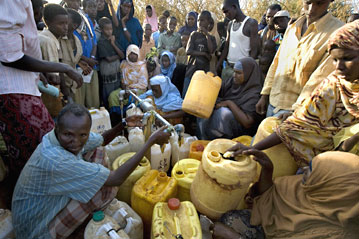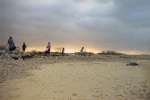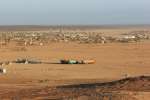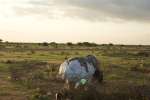- Text size
 |
|  |
|  |
| 
- Français
Dadaab camps under severe strain as Somalis continue to flee to Kenya
News Stories, 27 March 2009

DADAAB, Kenya, March 27 (UNHCR) – The election of a new Somali president earlier this year has failed to stem the flow of Somalis seeking refuge in the overcrowded Dadaab refugee camps in north-east Kenya.
Since the beginning of the year, more than 20,000 new arrivals have been registered in the three camps that make up the Dadaab complex – Hagadera, Ifo and Dagahaley. Many of the new arrivals UNHCR has interviewed cite increased insecurity, especially in the middle and lower Juba regions, coupled with drought and food shortages as the main reasons for fleeing to Kenya.
Many also express pessimism about the return of peace to Somalia in the near term. Despite the election in January of a moderate Islamist, Sheik Sharif Sheik Ahmed, as Somali president, many parts of Somalia are still insecure – that's why the election was held among Somali lawmakers in Djibouti.
UNHCR continues to receive and register new arrivals despite the fact that the capacity of the camps is completely overstretched. Camps designed almost two decades ago to accommodate a total of 90,000 people are currently home to more than 261,000 people, making the Dadaab complex one of the world's oldest, biggest and most congested refugee sites.
The UN refugee agency has been negotiating with the government of Kenya to provide land for the construction of new camps, but this is yet to be finalized.
"We are therefore receiving and accommodating these refugees with a lot of difficulty," said a UNHCR spokesman, adding: "It is crucial for the government to provide us with land as soon as possible, where we can build other camps and thus decongest the existing camps and prepare for more people if the current arrival trend continues."
Over half the new arrivals are women and children and many are exhausted after having travelled long distances, often using unofficial routes to avoid detection when crossing the border. Some come from as far away as Mogadishu by road and foot, an 800-kilometre journey that can take up to 16 days.
When they arrive, they must seek out family, relatives or clan members in Ifo and Dagahaley camps as UNHCR has no more land on which to give them plots to live, This results in up to 30 people living on a 12 by 13-metre plot of land.
"We fear that the situation may further deteriorate once the rainy season begins due to the shelter constraints. The next rainy season is expected in early April," the spokesman said.
The current conflict in Somalia has led to thousands of deaths and massive displacements. The Dadaab refugee camps were established in 1991 and 1992, following the collapse of the government of Siad Barre in Somalia.














































